Charity Bridges to Prosperity works with civil engineering organisations to build trail bridges in underdeveloped countries, in a bid to eradicate rural community isolation and infrastructure inequality. NCE finds out that its work in fact offers more than that.
With the rise of global poverty traps, many nations have been left behind in their ability to build infrastructure that serves rural communities.
To bridge a spiralling infrastructure- financing gap in developing countries, the UN Conference on Trade and Development estimated in 2014 that between £1.3tn and £1.9tn would be required annually for the period from 2015 to 2030.
In response to this challenge, wealthier nations began to set up multilateral development banks. The G7 launched the global infrastructure investment initiative when its summit was held in the UK in Carbis Bay in 2021. This initiative was established as a vehicle for G7 nations to help finance the building of long-neglected infrastructure in low- and middle-income countries.
Even with the funding that’s being provided to underdeveloped nations, communities outside urban areas are still significantly affected by a sense of exclusion. Rural isolation – defined as an area that is more than 2km away from an all-season road – impacts communities by restricting their access to healthcare or educational services, as well as a raft of other basic human needs.
In 2023, the US International Development Finance Corporation predicted more than 600M people in Africa lacked access to basic healthcare services.
Bridges to Prosperity (B2P) was formed as a charity by Kenneth Frantz in 2001. Frantz launched the organisation after seeing a photo of rural villagers traversing a broken bridge across Ethiopia’s Blue Nile in National Geographic.
B2P was set up as a non-profit organisation to fix this bridge, which it did successfully, but also to dampen the effect of rural isolation on communities across the world by part-funding and building other footbridges to connect villages and towns with key amenities.
B2P East Africa corporate manager Tina Gunnarsson explains how much difference a simple footbridge can make to areas that suffer from rural isolation.
“Something as simple as a footbridge will turn a two or three-hour round trip into a five to 10 minute journey to access vital services,” she says.
Journey time isn’t the only issue. B2P senior corporate programme manager Nicola Turrini stresses the importance of a simple footbridge in offering isolated communities a sense of safety too.
“We’re taking away the need for these people to make a choice,” he says. “They will not need to think the next time they need to go to school, to a market or to go to the hospital to deliver a baby.
“They will not need to think if it’s raining or not or if they can pass or not, they will just be able to cross a bridge safely and reach a service.”
Since its inception 20 years ago, B2P has built more than 700 bridges across 22 countries, providing more than 4.2M people with safer access to services.
Locations
B2P has worked in 22 countries, the majority across sub-Saharan Africa, South America and Southeast Asia, but currently operates in four.
In order to get the green light for bridge construction, B2P used to approach individual districts.
“Nowadays, we have developed an approach of signing a Memorandum of Understanding directly with the central governments of the countries we work in, rather than approaching individual districts one by one every year,” Turrini says.
At the turn of the decade, B2P partnered with Rwanda’s government to build over 200 trail bridges between 2019 and 2024.
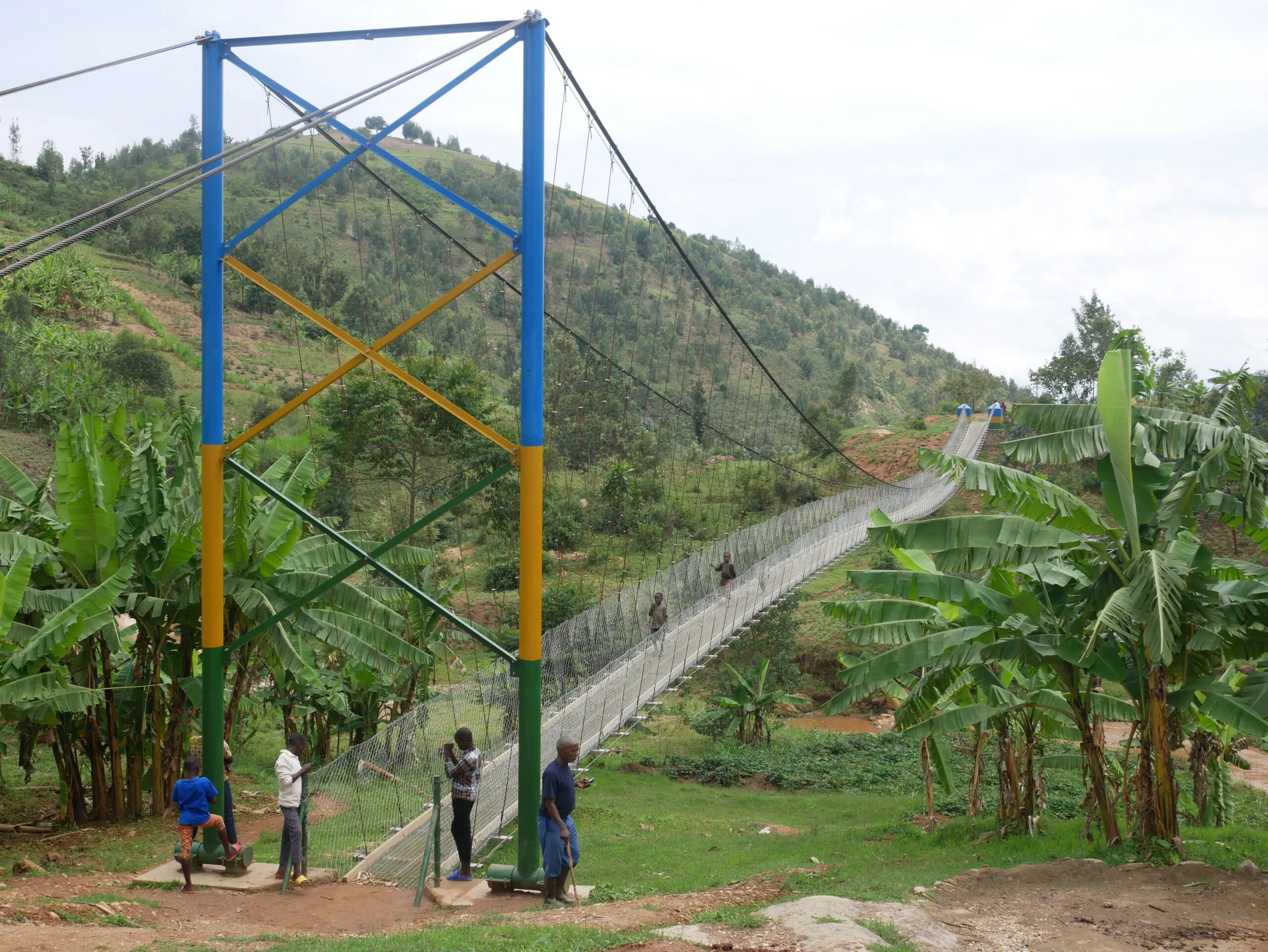
At the turn of the decade, B2P partnered with Rwanda’s government to build over 200 trail bridges between 2019 and 2024, including the Nyakabande-Bitaba Bridge. Picture credit: Bridges to Prosperity.
Even while forming partnerships, locating sites for the bridges still requires a lot of work from B2P.
“There is the historical way of carrying out needs assessments in which we approach a government for long lists of communities that they have flagged as needing a bridge. That’s what happened in Rwanda in 2018 – we received a list from each district of the country,” Turrini explains.
“That brought us to have more than 1500 sites flagged as needing a bridge. At that point, we trained assessors and sent them out to make a social and technical assessment and then used that data to identify the locations that needed the footbridges the most.”
The organisation is moving to more of a digital assessment approach now, utilising remote analysis tools, including machine learning, to locate where building infrastructure for improved access is most beneficial.
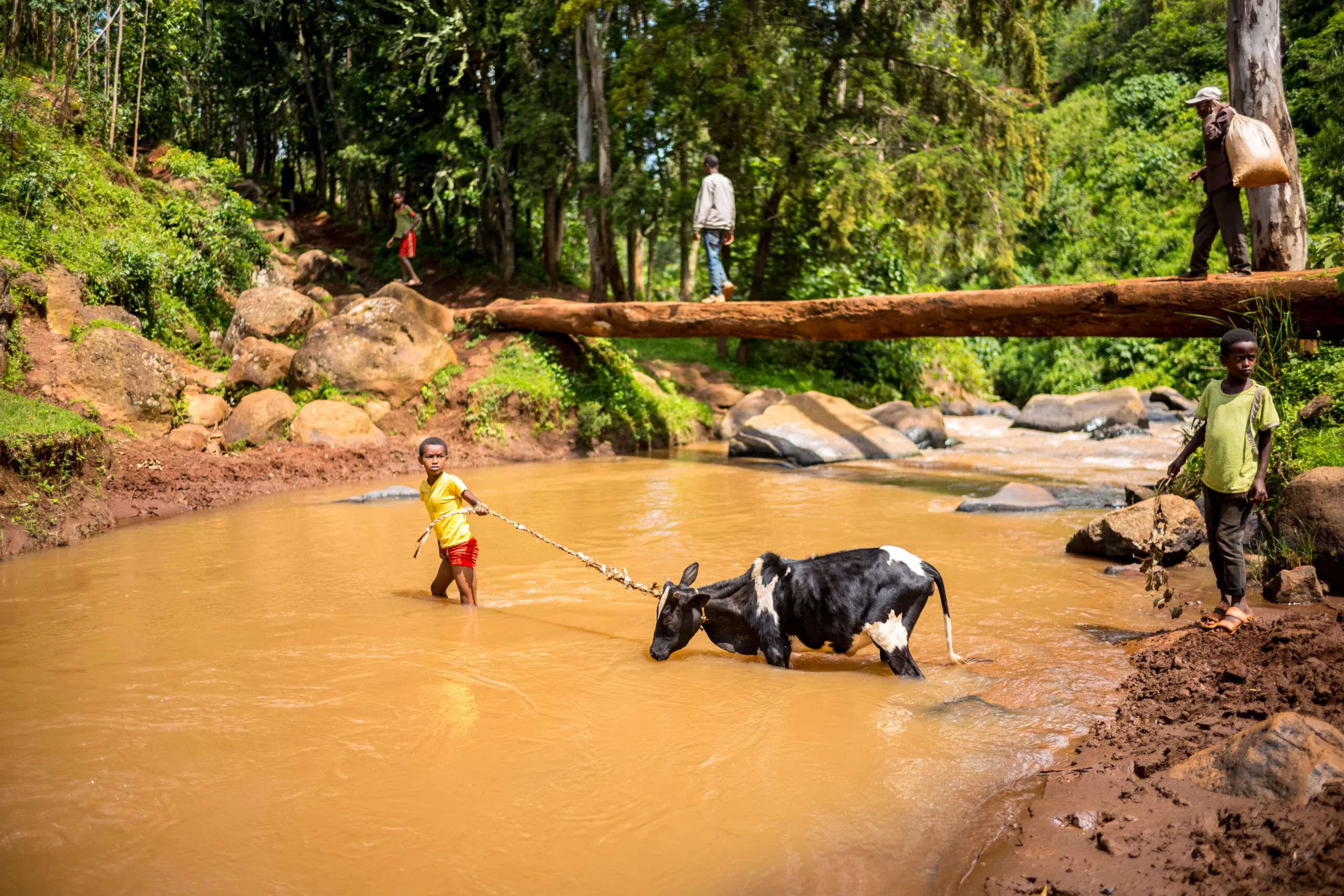
The organisation is now utilising remote analysis tools, including machine learning, to locate where building infrastructure for improved access is most beneficial, such as for the Jigesa Bridge site in Ethiopia. Picture Credit: Robb Hohmann.
The bridge
B2P now has two types of bridge it is rolling out at the locations it identified. More recently, the organisation has been constructing stone arch bridges. Although these have only been built in Rwanda so far, B2P intends to roll out the design to other countries soon.
Ideas for this form of bridge came from “seeing climate change events happening on a yearly basis now,” says Turrini.
“The issue was that we’ve seen a lot of smaller rivers and streams that are still impossible to cross during floodings but need a bridge that is too short of a span to be economically feasible for other bridge types.”
It’s a short span stone arch bridge made to serve a specific type of valley or type of river that needs specific geotechnical and hydrological conditions.
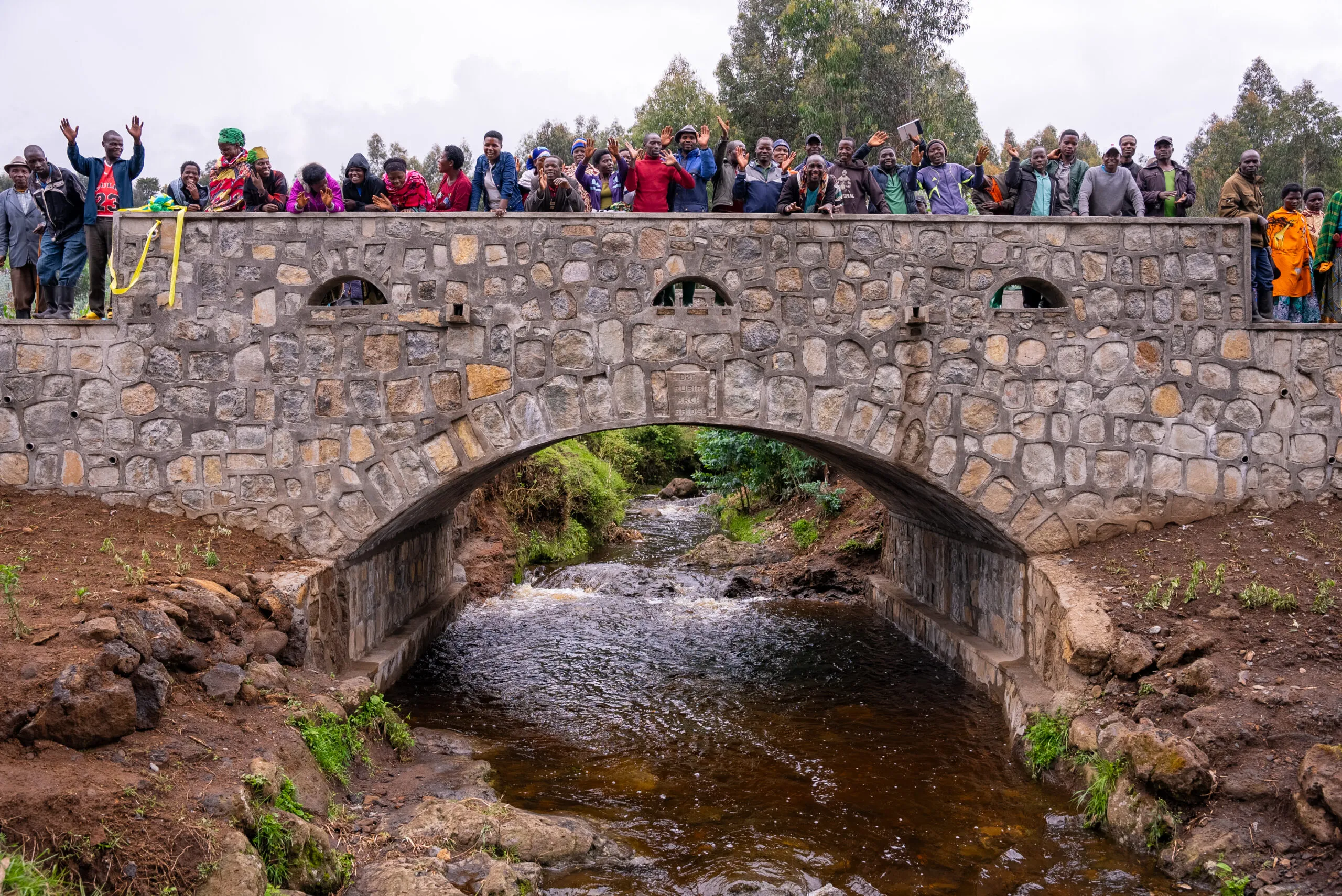
Climate change events mean the organisation has been constructing stone arch bridges in Rwanda recently, such as the Rubira Bridge, with the aim to roll out the design to other countries soon. Picture credit: Envision Rwanda.
“This bridge design permits us to find a solution that is not only cost- effective for these short span bridges but also completely made with local material, which is stone mortar, sand and gravel.
“It’s another perceivable step in the sustainability direction,” Turrini explains.
B2P’s more traditional design is a steel-deck cable-suspended trail bridge.
“The foundations are all made by hand from concrete and rebars. The concrete is mixed generally by hand as well, it’s a lot of work,” Turrini says.
“We use stone for some elements of the ramps and the perimeter of the pedestals below the suspension towers and we have the major steel work in the suspension towers where an interesting, donated material is the pipes.
“We use steel pipes that are donated, which we then provide to our local fabricators for them to cut and weld.”
The towers on either side of the crossing can be up to 10m high, Turrini explains.
For the cable, B2P’s standardised design uses closed steel wire rope cable anchored with saddle and hook type clips.
“We get donated shipping cables from Dubai and the US typically used for ports,” Gunnarsson says.
“They’ve got a very strong capacity and then we reuse those pretty much as is. We do our inspection and maintenance but there is no recycling, there’s no melting and creating a new product. They become the main bridge component.”
This circular economy thinking is something B2P is trying to increase with its infrastructure builds and can also be seen in the hangers that suspend from the cables, which are made of rebar.
“Why rebar?” Turrini asks. “Because they are extremely easy to find in any construction market locally, anywhere in the world.”
But also why suspended trail bridges? “These are pedestrian trail bridges and they work really well in rural communities found particularly in places like Rwanda where it’s a very pedestrian society and that’s exactly what we want to encourage,” Gunnarsson explains.
“It’s really good in terms of carbon footprint, in terms of health, in terms of everything really.”
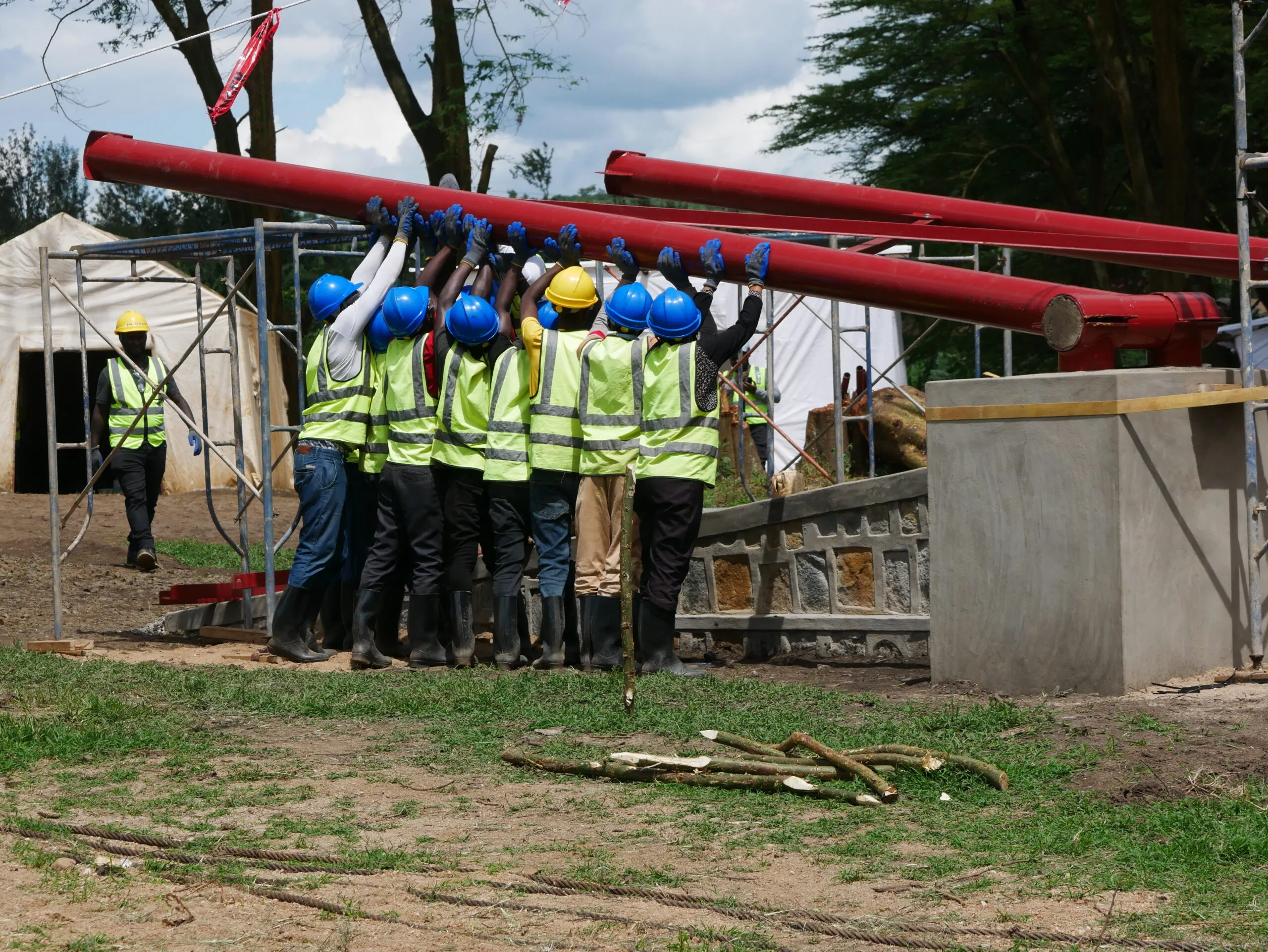
Building the Cyenjojo Bridge in Rwanda. Picture Credit: Bridges to Prosperity.
Volunteers
While B2P’s own team constructs the bridge foundations, it relies on workers from the communities it serves and volunteers from international commercial contractors to construct and install the bridge’s superstructure.
Volunteers from contractors in the UK fundraise for a trip to help build the bridges.
This year, 10 employees from Tony Gee and Knights Brown constructed a 74m suspension footbridge in Jurama, Rwanda over the River Rusumo in nine days. This was the fifth project the three organisations had partnered on.
Speaking highly of his time in Rwanda, Knights Brown civil engineer Navid Zamani explains how as much as he expected to be able to teach local volunteers about his work, the knowledge sharing worked both ways.
“It wasn’t just us teaching them or showing them how to do stuff,” he says. “They were showing us how to do stuff as well. We had a team from the community over there who knew basically everything about building bridges.
“They showed us how to bend bars to the design specifications.”
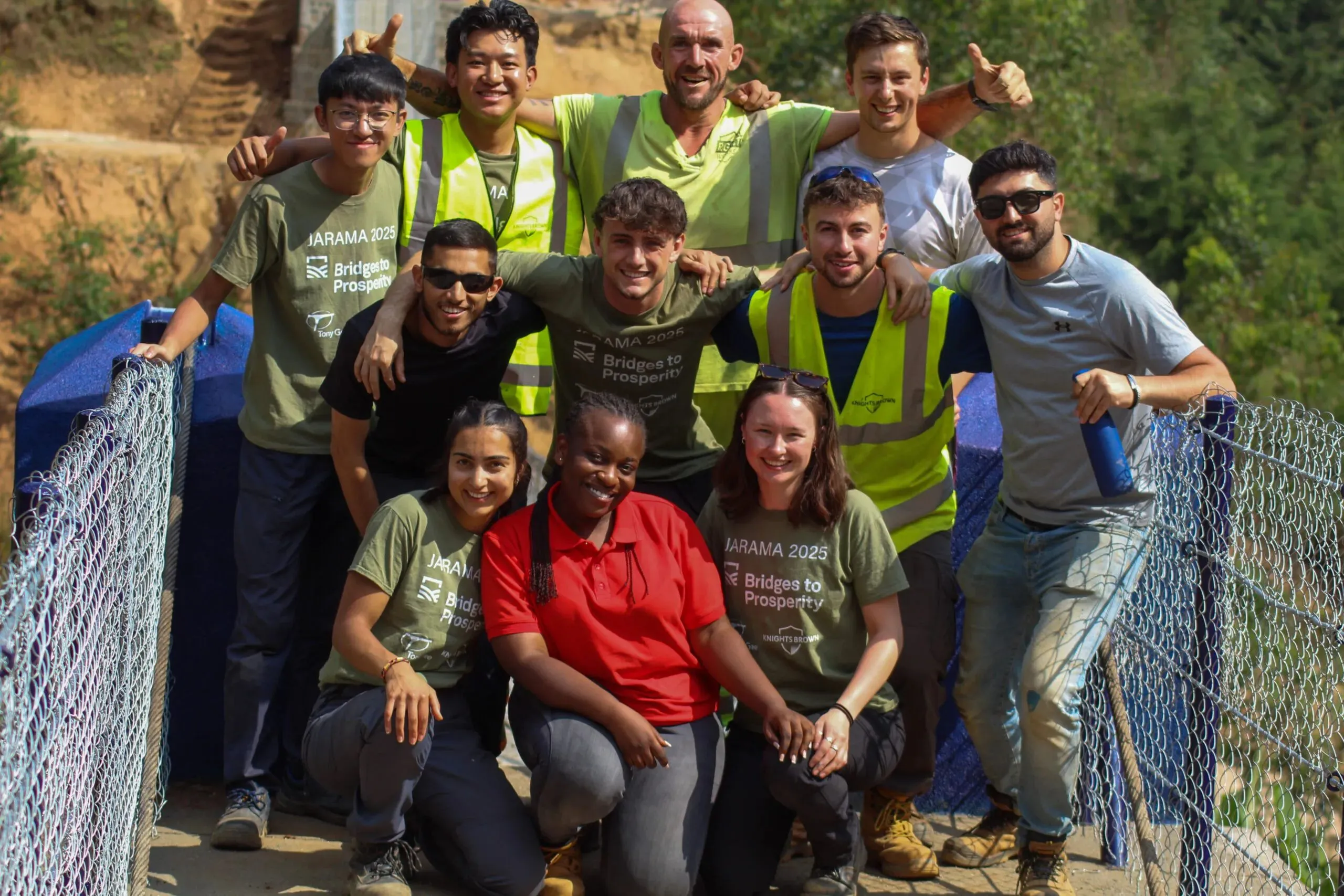
This year, 10 employees from Tony Gee and Knights Brown constructed a 74m suspension footbridge in Jurama, Rwanda, the fifth project the three organisations had partnered on
Tony Gee design engineer India Ross describes how she was rewarded by the palpable benefits the community expressed on the inauguration day.
“On the final day when we’d finished the bridge we did an inauguration ceremony, which was just an amazing celebration,” she says. “You could see on all the faces how happy everyone was about it being built and there are testimonials from local community members about how it would benefit them.
“They told us how the secondary school is one side of the river, so for kids to get to secondary school in rainy season the bridge would enable that.”
With the inauguration clearly a special event, Zamani notes that being the first person to test the new bridge didn’t scare him at all.
“They made me walk over the bridge first, I had to test the bridge myself,” he says.
“But I wasn’t scared at all because I trusted myself and I trusted the team so I knew the bridge was really safe.”
Beyond the amazing experience constructing the bridge gave them, Ross says what she will take home is just as powerful.
“I would say it gave me a renewed sense of purpose and highlighted how important good infrastructure is,” she says.
“Every person on the team said they absolutely loved the experience but also that they learned a lot and it’s really important to hear of all the impacts and the difference a piece of infrastructure can make.”
Legacy
Now that B2P has been in operation for more than 20 years, the organisation has changed its tack around the legacy it wants to leave behind after its infrastructure is in place.
“In more than two decades, we’ve connected almost 4M people. That seems a big number but in relation to the real numbers of people that suffer or are affected by poverty caused by rural isolation, it’s nothing,” Turrini says.
B2P assesses that number to be a minimum of 200/300M people up to 1bn. “It’s a range that is a big order of magnitude above what we can do alone.”
To manage this order of magnitude, B2P is now working towards transferring construction skills and capabilities to the nations it aids.
“We are now embracing an effort to pass from being the sole builders, the sole ones designing and building and doing all of the 700 bridges to actually become enablers,” Turrini says.
“When I say promote rather than build, it describes how we are working on a systems change to create an environment where local private sector and local government can meet and have the technical support they need in order to build their own infrastructure.”
Beyond B2P’s attempts at empowering rural isolated communities to be able to design, plan, build and install their own infrastructure, the bridges themselves leave a tangible legacy.
“This is why we’re so passionate about this,” Gunnarsson says. “It’s really rare as an engineer to get to interface with the end user. You almost never get to meet the people who use the infrastructure that you build.
“Here, you go out and you’re immediately surrounded by the 800 children who are using the bridge daily to get to school.
“There’s so much energy and momentum and excitement around these bridges.”
Like what you’ve read? To receive New Civil Engineer’s daily and weekly newsletters click here.


